Eggplants are a popular vegetable in many households due to their versatility in cooking. However, eggplant plants are not immune to diseases and other plant problems, one of which is the development of brown spots on the leaves, stems, and fruits.
These brown spots on eggplant leaves can be caused by various factors, including fungal diseases, environmental factors, and insect pests.
Understanding the causes and identifying the symptoms of brown spots on eggplant leaves is crucial in preventing further damage to the plant. In some cases, brown spots on eggplant leaves can be an indication of a serious disease that could potentially kill the plant.
Therefore, it is important to take action as soon as you notice any signs of brown spots on your eggplant leaves.
Key Takeaways
- Brown spots on eggplant leaves can be caused by various factors, including fungal diseases, environmental factors, and insect pests.
- Identifying the causes and symptoms of brown spots on eggplant leaves is crucial in preventing further damage to the plant.
- Taking preventative measures and implementing treatment strategies can help protect your eggplant plants from brown spots and other diseases.
Also see:
Understanding Brown Spots on Eggplant Leaves
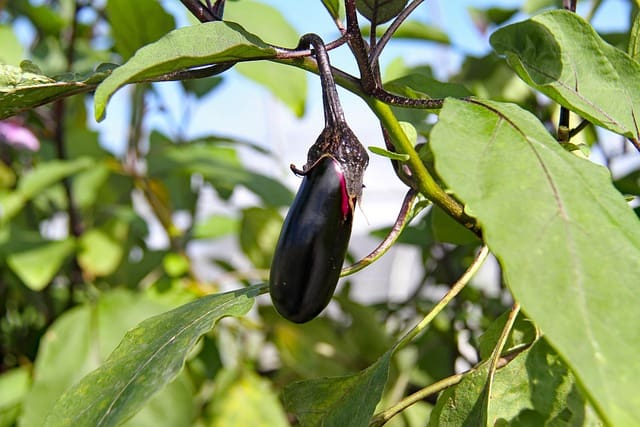
Brown spots on eggplant leaves are a common issue that can cause significant damage to the plant if left untreated. These spots can be caused by different factors, including fungal diseases, insect pests, and environmental stress.
Brown Spots on Eggplant Leaves – 3 Common Problems
1. Fungal Diseases
Fungal diseases are one of the most common causes of brown spots on eggplant leaves. Fungi such as Alternaria solani, Phytophthora capsici, and Rhizoctonia solani can cause leaf spots on eggplants.
These spots are small, circular-to-oval, and initially appear as chlorotic before turning gray to brown on the upper leaf surface and light-brown on the lower leaf surface. As the disease progresses, concentric rings of diseased tissues may develop with sporulation in the center of spots.
2. Insect Pests
Insect pests such as flea beetles are another cause of brown spots on eggplant leaves. These pests have chewing mouthparts and feed on leaves, making small, shot-like holes. Their damage is most serious when the plants are small and have just a few leaves.
3. Environmental Stress
Environmental stress can also cause brown spots on eggplant leaves. Lack of enough moisture in the soil will affect eggplant production and, in some cases, can cause the leaves to turn brown and become soft.
Treatment for Brown Spots on Eggplant Leaves
The treatment for brown spots on eggplant leaves depends on the underlying cause. For fungal diseases, it is essential to remove and destroy infected plant parts, apply fungicides, and practice proper crop rotation to prevent the spread of the disease.
For insect pests, it is crucial to apply insecticides and practice proper crop rotation. For environmental stress, it is essential to ensure that the plants are adequately watered and that the soil is well-drained.
Identifying Common Eggplant Diseases
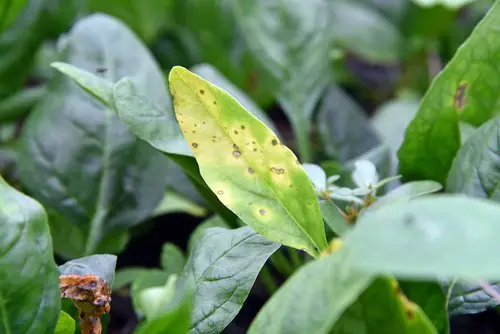
Eggplants are susceptible to various diseases that can cause brown spots on their leaves. Identifying these diseases early is crucial to prevent further damage to the plant. In this section, we will discuss the three most common eggplant diseases that cause brown spots on leaves.
1. Early Blight
Early blight is a fungal disease caused by Alternaria solani that affects eggplants and other plants in the nightshade family. The first signs of early blight are brown spots on the lower leaves that gradually spread to the upper leaves.
The spots are usually circular and have a target-like appearance with a dark brown center and yellowish margins. As the disease progresses, the leaves turn yellow and eventually fall off.
Early blight is most prevalent in warm and humid weather conditions. It can spread rapidly through splashing rain, irrigation, or wind-blown spores. To prevent early blight, avoid overhead watering, keep the soil well-drained, and space the plants to promote good air circulation.
Fungicides can also be used to control early blight, but they should be applied before the disease becomes severe.
2. Alternaria Solani
Alternaria Solani is another fungal disease that affects eggplants and other nightshade plants. It causes brown spots on the leaves, which can quickly spread to the stem and fruit.
The spots are usually circular and have a dark brown center with a yellowish margin. The affected leaves may curl and wilt, and the fruit may become sunken and rotten.
Alternaria Solani thrives in warm and humid weather and can spread through wind-blown spores, rain, or irrigation. To prevent Alternaria Solani, avoid overhead watering, keep the soil well-drained, and space the plants to promote good air circulation.
Fungicides can also be used to control Alternaria Solani, but they should be applied before the disease becomes severe.
3. Phytophthora Capsici
Phytophthora Capsici is a fungal disease that can cause severe damage to eggplants and other nightshade plants. It causes brown spots on the leaves, which can quickly spread to the stem and fruit.
The spots are usually circular and have a dark brown center with a yellowish margin. The affected leaves may curl and wilt, and the fruit may become sunken and rotten.
Phytophthora Capsici thrives in warm and humid weather and can spread through wind-blown spores, rain, or irrigation. To prevent Phytophthora Capsici, avoid overhead watering, keep the soil well-drained, and space the plants to promote good air circulation.
Fungicides can also be used to control Phytophthora Capsici, but they should be applied before the disease becomes severe.
Role of Environmental Factors

Environmental factors play a crucial role in the development of brown spots on eggplant leaves. These factors can include water, soil, pH, moisture, overhead watering, environmental stress, full sun, overcrowding, and airflow.
Overhead watering can increase the amount of moisture on the leaves, which can create an environment for fungal growth. It is recommended to use drip irrigation instead of overhead watering to minimize the amount of water on the leaves.
Environmental stress, such as extreme temperatures or drought, can also lead to brown spots on eggplant leaves. It is important to provide adequate moisture and shade during hot weather to prevent stress on the plant.
Full sun can also contribute to brown spots on eggplant leaves. If the plant is in an area with intense sunlight, it may be necessary to provide some shade to prevent sunscald and other damage.
Overcrowding can also lead to brown spots on eggplant leaves. When plants are too close together, there is less airflow, which can create a humid environment that is conducive to fungal growth. It is important to provide adequate spacing between plants to promote airflow.
The pH of the soil can also affect the development of brown spots on eggplant leaves. Eggplants prefer a slightly acidic soil with a pH between 5.5 and 6.5. If the soil is too alkaline, it may be necessary to add sulfur to lower the pH.
Impact on Eggplant Parts
1. Fruit
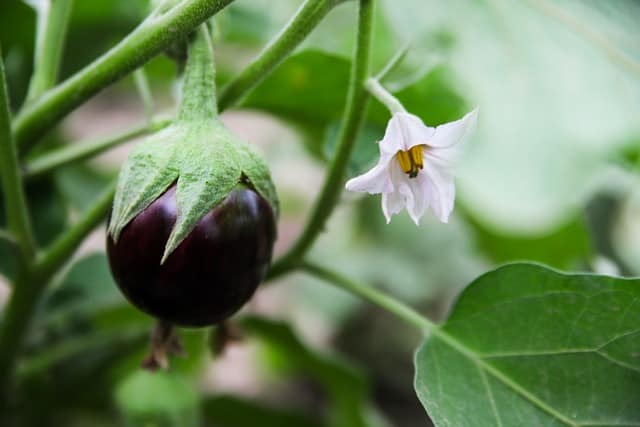
Brown spots on eggplant leaves can have a significant impact on the fruit. If the disease progresses, it can cause the fruit to rot and become inedible.
In some cases, the fruit may still be edible, but the quality and taste may be affected. It is important to monitor the fruit closely and remove any affected fruit to prevent the spread of the disease.
2. Stem
The stem of the eggplant can also be affected by brown spots. If the disease progresses, it can cause the stem to weaken and eventually break. This can lead to the death of the plant. It is important to monitor the stem closely and remove any affected parts to prevent the spread of the disease.
3. Foliage
Brown spots on eggplant leaves can cause the foliage to wither and die. This can impact the plant’s ability to photosynthesize and produce food, leading to stunted growth and reduced yield. It is important to remove any affected foliage to prevent the spread of the disease.
4. Skin
If brown spots develop on the skin of the eggplant, it can impact the visual appeal of the fruit. This can make it difficult to sell or use in culinary applications. It is important to monitor the skin closely and remove any affected fruit to prevent the spread of the disease.
5. Flesh
If brown spots develop on the flesh of the eggplant, it can impact the taste and texture of the fruit. In some cases, the flesh may become soft and mushy, making it unsuitable for culinary applications. It is important to monitor the flesh closely and remove any affected fruit to prevent the spread of the disease.
6. Blossoms
Brown spots on eggplant blossoms can impact the plant’s ability to produce fruit. If the disease progresses, it can cause the blossoms to fall off before they have a chance to develop into fruit. It is important to monitor the blossoms closely and remove any affected parts to prevent the spread of the disease.
Insect Pests and Their Role
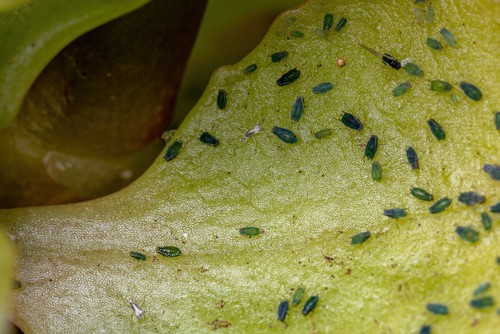
Eggplants are susceptible to a variety of insect pests that can cause brown spots on the leaves. These pests can cause significant damage to the plant if not controlled. In this section, we will discuss some of the most common insect pests and their role in causing brown spots on eggplant leaves.
1. Aphids
Aphids are small, soft-bodied insects that feed on the sap of the plant. They can be found on the undersides of leaves and can cause yellowing and curling of the leaves.
They secrete a sticky substance called honeydew, which can attract other insects and lead to the growth of sooty mold. Aphids can be controlled with insecticidal soap or neem oil.
2. Flea Beetles
Flea beetles are small, jumping insects that feed on the leaves of the plant. They can cause small, shot-like holes in the leaves and can stunt the growth of the plant. Flea beetles can be controlled with insecticidal soap or neem oil.
3. Hornworms
Hornworms are large, green caterpillars that can eat large amounts of foliage. They can cause extensive damage to the plant if not controlled. Hornworms can be hand-picked off the plant or controlled with Bacillus thuringiensis (BT).
4. Colorado Potato Beetle
The Colorado potato beetle is a common pest of eggplants. The adult beetle is characterized by a golden color with 10 distinctive vertical black stripes down the back of the body. The larvae of the beetle are somewhat smaller and much darker.
They can cause extensive damage to the leaves and can defoliate the plant if not controlled. Colorado potato beetles can be controlled with insecticides or neem oil.
5. Spider Mites
Spider mites are tiny, eight-legged pests that feed on the undersides of leaves. They can cause yellowing and stippling of the leaves and can cause the leaves to fall off the plant. Spider mites can be controlled with insecticidal soap or neem oil.
6. Whiteflies
Whiteflies are small, white insects that feed on the sap of the plant. They can cause yellowing and curling of the leaves and can stunt the growth of the plant. They secrete honeydew, which can attract other insects and lead to the growth of sooty mold. Whiteflies can be controlled with insecticidal soap or neem oil.
7. Green Peach Aphid
The green peach aphid is a common pest of eggplants. They can cause yellowing and curling of the leaves and can stunt the growth of the plant. They secrete honeydew, which can attract other insects and lead to the growth of sooty mold. Green peach aphids can be controlled with insecticidal soap or neem oil.
8. Tomato Hornworms
Tomato hornworms are large, green caterpillars that can eat large amounts of foliage. They can cause extensive damage to the plant if not controlled. Tomato hornworms can be hand-picked off the plant or controlled with Bacillus thuringiensis (BT).
9. Stink Bugs
Stink bugs are shield-shaped insects that can cause damage to the fruit of the plant. They can cause brown spots on the fruit and can cause the fruit to become deformed. Stink bugs can be controlled with insecticides or neem oil.
10. Tetranychus Urticae
Tetranychus urticae, also known as the two-spotted spider mite, is a common pest of eggplants. They can cause yellowing and stippling of the leaves and can cause the leaves to fall off the plant. Tetranychus urticae can be controlled with insecticidal soap or neem oil.
11. Flies
Flies can lay eggs on the leaves of the plant, which can hatch into maggots that feed on the plant. They can cause extensive damage to the plant if not controlled. Flies can be controlled with insecticides or neem oil.
Prevention and Treatment Strategies
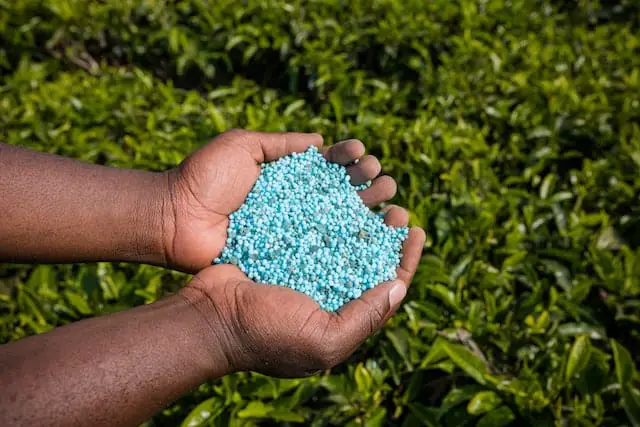
Preventing brown spots on eggplant leaves is crucial to maintaining the health of the plant and ensuring a successful harvest. Here are some strategies to prevent and treat brown spots on eggplant leaves:
Prevention Strategies
Watering: Overwatering can lead to fungal growth and increase the risk of brown spots on eggplant leaves. Water the plant at the base and avoid getting the leaves wet. Use a drip irrigation system to reduce the risk of fungal infections.
Fertilizer: Proper fertilization can help prevent brown spots on eggplant leaves. Use a balanced fertilizer and avoid over-fertilizing, which can lead to excessive growth and increase the risk of fungal infections.
Spacing: Proper spacing between plants can help increase airflow and reduce the risk of fungal infections. Space plants at least 18 to 24 inches apart.
Weed Management: Weeds can increase humidity levels and reduce airflow, leading to fungal growth. Keep the garden free of weeds to reduce the risk of brown spots on eggplant leaves.
Treatment Strategies
Cultural Control: Remove any infected leaves as soon as possible to prevent the spread of the disease. Bury infected crop debris or remove and destroy infected leaves.
Insecticidal Soap: Insecticidal soap can be effective in controlling pests like stink bugs and leaf-footed bugs, which can cause brown spots on eggplant leaves. Spray the plant with insecticidal soap according to the manufacturer’s instructions.
Fungicides: Fungicides can be effective in controlling fungal infections that cause brown spots on eggplant leaves. Copper spray and neem oil are effective options for organic gardeners. For conventional gardeners, bifenthrin and permethrin are effective options.
Chemical Control: Chemical control can be effective in controlling pests and diseases that cause brown spots on eggplant leaves. Always follow the manufacturer’s instructions when using chemical control.
Spinosad: Spinosad is an organic insecticide that can control pests like stink bugs and leaf-footed bugs. It is safe for use on vegetables and can be effective in controlling brown spots on eggplant leaves.
By following these prevention and treatment strategies, gardeners can reduce the risk of brown spots on eggplant leaves and ensure a healthy and successful harvest.
Comparison with Other Plants
1. Potatoes
Potatoes and eggplants belong to the same family, Solanaceae, and share some common pests and diseases. However, potatoes are more susceptible to late blight, a fungal disease that can cause brown spots on the leaves and stems.
Late blight can also affect eggplants, but it is less common. In addition, potatoes are vulnerable to early blight, a fungal disease that can cause brown spots on the leaves and stems, similar to eggplants.
2. Tomatoes

Tomatoes are also part of the Solanaceae family and can suffer from similar diseases as eggplants. One of the most common diseases that affect tomatoes is early blight, which can cause brown spots on the leaves and stems.
However, the symptoms of early blight on tomatoes are slightly different from those on eggplants. On tomatoes, the spots are usually surrounded by a yellow halo, while on eggplants, the spots are surrounded by a dark ring.
3. Peppers
Peppers are another member of the Solanaceae family and can suffer from similar diseases as eggplants. One of the most common diseases that affect peppers is bacterial spot, which can cause brown spots on the leaves and fruits. The spots on peppers are usually smaller and more numerous than those on eggplants.
4. Aubergine
Aubergine is simply another name for eggplant, so it is not surprising that they share many of the same diseases. One of the most common diseases that affect eggplants is early blight, which can cause brown spots on the leaves and stems.
The symptoms of early blight on aubergines are similar to those on eggplants, with the spots surrounded by a dark ring.
Overall, while eggplants share some common pests and diseases with other Solanaceae family members such as potatoes, tomatoes, peppers, and aubergines, the symptoms of these diseases may differ slightly.
Frequently Asked Questions
How do you treat eggplant leaf spots?
The treatment for eggplant leaf spots depends on the cause of the spots. If the spots are caused by a fungal infection, it is recommended to remove the infected leaves and treat the plant with a fungicide.
If the spots are caused by a bacterial infection, the affected leaves should also be removed, and the plant should be treated with a bactericide.
It is also important to maintain good plant hygiene, such as keeping the soil moist but not waterlogged, not overcrowding plants, and avoiding overhead watering.
Why do my eggplant leaves have brown spots?
Eggplant leaves can develop brown spots due to a variety of reasons, including fungal or bacterial infections, insect infestations, environmental stress, and nutrient deficiencies. It is important to identify the cause of the brown spots in order to provide the appropriate treatment.
Is eggplant with brown spots bad?
Eggplants with brown spots on the leaves are not necessarily bad to eat, but it is important to inspect the fruit for any signs of disease or damage. If the fruit appears healthy and undamaged, it is safe to consume.
What are the symptoms of phomopsis fruit rot in eggplant?
Phomopsis fruit rot in eggplant is characterized by brown spots on the fruit that eventually turn black and become sunken. The fruit may also develop a soft, watery rot and emit a foul odor. Infected fruit should be removed and destroyed to prevent the spread of the disease.
How to identify cercospora leaf spot of eggplant?
Cercospora leaf spot of eggplant is identified by small, circular-to-oval spots that turn gray to brown on the upper leaf surface and light-brown on the lower leaf surface.
As the disease progresses, the spots may develop concentric rings of diseased tissue with sporulation in the center of the spot. Severely infected leaves may turn yellow and fall off the plant.
What is the best eggplant fungus treatment?
The best eggplant fungus treatment depends on the specific fungus causing the infection. Fungicides containing copper, sulfur, or chlorothalonil are commonly used to treat fungal infections in eggplants.
It is important to follow the instructions on the fungicide label and to apply the fungicide at the first sign of infection.

Hey, I’m Lisa and I’ve been an avid gardener for over 30 years. I love writing, talking and living in the garden! Feel free to connect with me on my socials below


